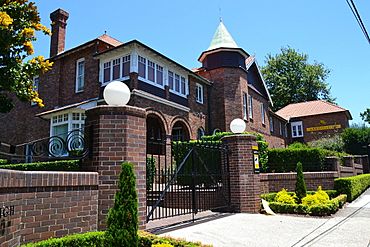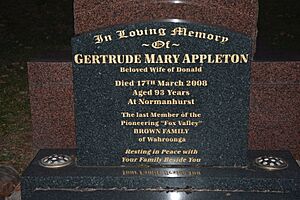Wahroonga, New South Wales facts for kids
Quick facts for kids WahroongaSydney, New South Wales |
|||||||||||||||
|---|---|---|---|---|---|---|---|---|---|---|---|---|---|---|---|

Marian Clarke Building, Abbotsleigh School, Wahroonga.
|
|||||||||||||||
| Established | 1822 | ||||||||||||||
| Postcode(s) | 2076 | ||||||||||||||
| Elevation | 202 m (663 ft) | ||||||||||||||
| Area | 8.2 km2 (3.2 sq mi) | ||||||||||||||
| Location | 18 km (11 mi) north-west of Sydney CBD | ||||||||||||||
| LGA(s) | Ku-ring-gai Council Hornsby Shire |
||||||||||||||
| State electorate(s) | Wahroonga | ||||||||||||||
| Federal Division(s) | Bradfield | ||||||||||||||
|
|||||||||||||||
Wahroonga is a suburb located in the Upper North Shore area of Sydney, New South Wales, Australia. It is about 18 kilometres north-west of the main city centre, the Sydney central business district. Wahroonga is managed by two local councils: Ku-ring-gai Council and Hornsby Shire. Nearby, you'll find North Wahroonga, which is a separate suburb but shares the same postcode.
Contents
Discovering Wahroonga's Past
The name "Wahroonga" comes from an Aboriginal word. It means "our home" and likely comes from the Kuringgai language group. When British settlers first arrived in New South Wales in the early 1800s, they liked the area for its tall trees.
Early Settlers and Land Use
Wahroonga was first settled by the British in 1822. A man named Thomas Hyndes, who had been a convict, became a rich landowner and was one of the first to live there.
Later, a merchant and timber-getter named John Brown bought Hyndes's land. After cutting down the trees, Brown planted fruit orchards. Some streets in Wahroonga, like Ada, Lucinda, and Roland Avenues, are named after his children. You can also find his name in Browns Road, Browns Field, and Browns Waterhole. The last person from the Brown family, Gertrude Mary Appleton, passed away in 2008.
Growth of a Garden Suburb
In 1890, the North Shore railway line opened. This made Wahroonga a popular spot for wealthy business people. They built large homes with beautiful gardens away from the city. The Wahroonga Post Office opened in 1896. Much of the area's growth happened in the 1920s and 1930s.
Today, Wahroonga is known as a "garden suburb." Its streets are lined with trees, and many historic houses remain. These homes show different architectural styles from the past.
Homes and Historic Places
Wahroonga is famous for its tree-lined streets and well-kept gardens. Some well-known streets include Water Street, Burns Road, Iloura Avenue, and Billyard Avenue.
Special Heritage Homes
Wahroonga has many places that are listed for their historical importance. These "heritage-listed" sites are protected because they are special. Some of them include:
- 9 Highlands Avenue: Highlands
- 62 Boundary Road: Jack House
- 69–71 Clissold Road: Rose Seidler House
- 61–65 Coonanbarra Road: St John's Uniting Church, Wahroonga
- 16 Fox Valley Road: Purulia
- 69 Junction Road: Evatt House
- North Shore railway: Wahroonga railway station
- 1526 Pacific Highway: Mahratta
- 1678 Pacific Highway and Woonona Avenue: Wahroonga Reservoir
- 23 Roland Avenue: Simpson-Lee House I
- 14 Woonona Avenue: The Briars
Highlands is a timber house on Highlands Avenue. It was built in 1891 for Alfred Hordern and designed by John Horbury Hunt. Hunt was a Canadian architect who used the Arts and Crafts and Shingle Style popular in North America.
Purulia, on Fox Valley Road, was designed and built by architect William Hardy Wilson in 1913. This home is in the Colonial Revival style.
The Briars, on Woonona Avenue, was built in 1895. It is said to have a connection to Napoleon Bonaparte. The house was built for a grandson of the person who hosted Napoleon during his exile.
The Rose Seidler House, built by Harry Seidler between 1948 and 1950, was one of the first examples of modern house design in Australia.
Shopping and Businesses
The main shopping area is Wahroonga Village. It's right next to the railway station. Here you can find cafes, restaurants, health stores, and small shops. There's also an IGA supermarket.
Smaller shopping areas include the Hampden Avenue strip in east Wahroonga and Fox Valley Shopping Centre.
Another business area is at the crossing of Fox Valley Road and The Comenarra Parkway. This area includes the Sydney Adventist Hospital.
Getting Around Wahroonga
Train Services
Wahroonga railway station is on the North Shore railway line. You can catch frequent Sydney Trains services from here to Central Station in Sydney and Hornsby.
Road Connections
Wahroonga is the Sydney end of the M1 Motorway, which goes to Newcastle. The Pacific Highway also connects Wahroonga to other parts of the North Shore. Pennant Hills Road starts in Wahroonga and meets the M1 Motorway. The Comenarra Parkway is a smaller road that runs through Wahroonga. Wahroonga is also the northern end of the NorthConnex motorway tunnel.
Bus Services
CDC NSW provides bus services to different parts of Wahroonga, like the 576 bus to Turramurra Station.
Parks and Green Spaces
Wahroonga has several lovely parks:
- Wahroonga Park is near the railway station. It has many old trees, a rose garden, and a playground for kids.
- The Glade is close to Abbotsleigh School. It has a sports oval, two tennis courts, a half basketball court, and cricket nets. There's also a small Blue Gum High Forest nearby.
- Browns Field is a small sports oval. It used to be an area where timber was cut.
- Sir Robert Menzies Park is a small park in Fox Valley.
Ku-ring-gai Chase National Park is located north of Wahroonga. It's one of Australia's oldest national parks. It's a great place for walking, picnics, and seeing Aboriginal rock carvings. The park has many known Aboriginal sites in the Sydney area.
Schools in Wahroonga
Wahroonga has many schools for different age groups:
Primary Schools
- Wahroonga Public School
- Waitara Public School
- Prouille Catholic Primary School
- Wahroonga Preparatory School
- St Lucy's School for children with disabilities
Secondary Schools
- St Leo's Catholic College
- St Edmund's School for students with vision impairment and other special needs
K–12 Schools (Kindergarten to Year 12)
- Knox Grammar School
- Abbotsleigh School for Girls
- Wahroonga Adventist School
Images for kids
People of Wahroonga
Who Lives Here?
According to the 2021 census, there were 17,853 people living in Wahroonga.
- Most people (59.3%) were born in Australia. Other common birthplaces include China (8.2%), England (4.9%), and India (2.9%).
- Most people (67.9%) speak English at home. Other languages spoken include Mandarin (10.2%) and Cantonese (3.5%).
- For religion, many people said they had No Religion (35.5%). Other common religions were Catholic (19.5%) and Anglican (16.4%).
Famous People from Wahroonga
Many well-known people have lived in or are connected to Wahroonga:
- David Campese: A famous former Wallaby rugby player.
- Grace Cossington Smith: An Australian artist who helped start modern painting. She went to Abbotsleigh School.
- Adam Garcia: An actor.
- Peter Garrett: The lead singer of the band Midnight Oil and a former politician. He was born and grew up here.
- Mel Gibson: An actor who went to St Leo's Catholic College for high school.
- Hugh Jackman: A famous actor.
- Ellyse Perry: An Australian athlete who plays both football (soccer) and cricket for Australia.
- Jacob Preston: A rugby league player.
- Natalie Tobin: A football (soccer) player for Sydney FC.
- William Hardy Wilson: An architect, artist, and author.











